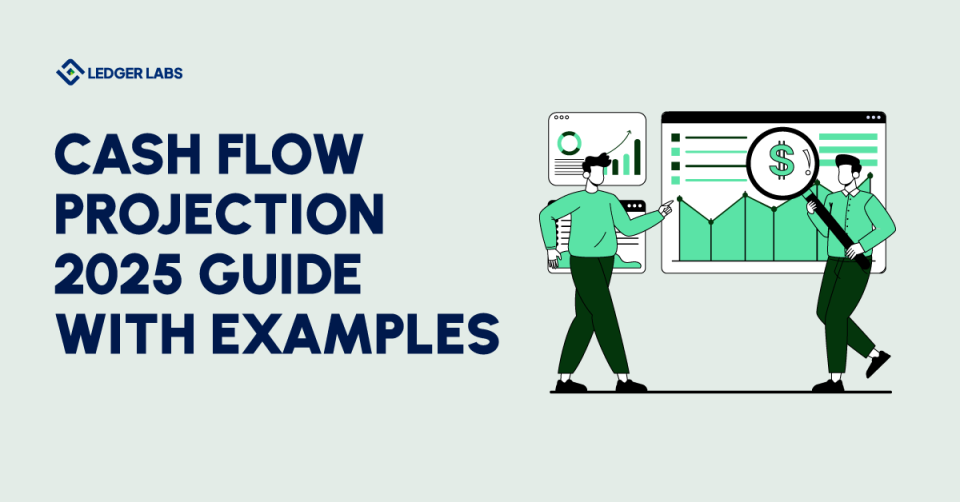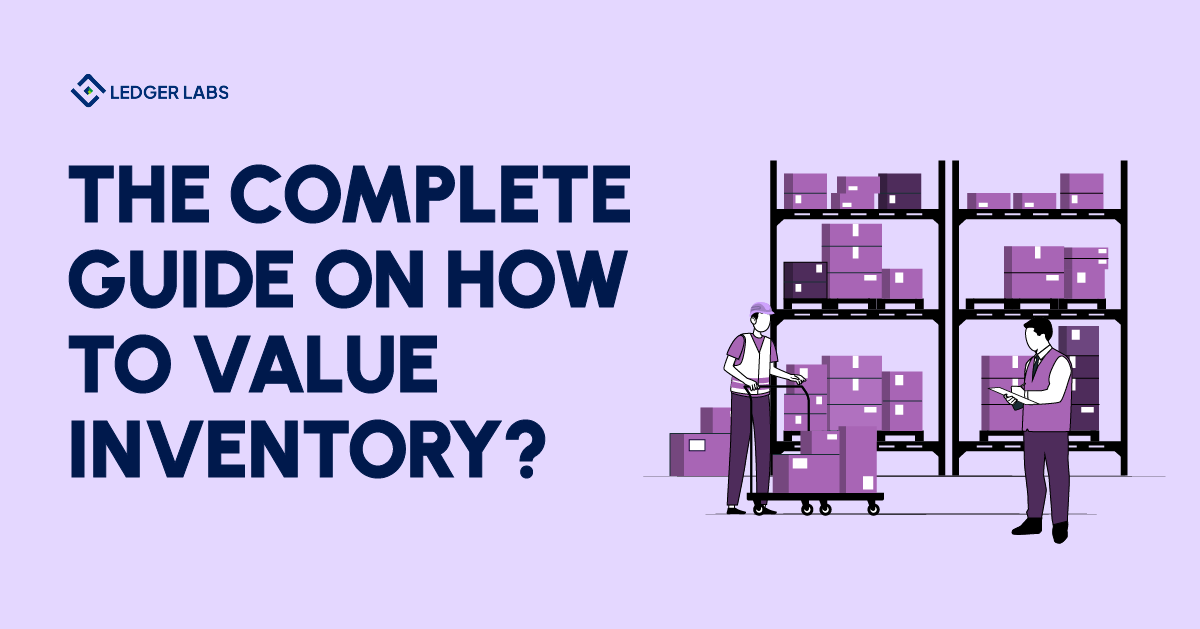82% of small business failures are tied to poor cash management.
That stat alone shows why “paper profit” doesn’t always keep the lights on. The real test is whether your business has enough cash in the bank to cover payroll, suppliers, and growth bets when they’re actually due.
That’s where a cash flow projection becomes your safety net. By mapping when money will come in and when it will go out, you get the foresight to avoid crunches, fund expansion, and keep stakeholders confident.
Key Takeaways
- Simple steps to build 12-month and 13-week projections.
- Templates you can download and adapt in minutes.
- Examples tailored for e-commerce, retail, and manufacturing.
- Common mistakes to avoid so your forecast stays realistic.
What Is a Cash Flow Projection?
How can a business look profitable on paper yet still run out of money? The answer often lies in not having a clear picture of timing. A cash flow projection solves this by mapping when money will actually enter and leave your bank account.
Definition: A cash flow projection is a forward-looking estimate of your company’s incoming and outgoing cash over a set period, helping you anticipate shortfalls and plan for growth.
Cash Flow Projection vs Forecast vs Budget
These three terms often get mixed up, but they serve different roles in financial planning:
- Cash Flow Projection: Estimates future cash activity based on assumptions, targets, or planned scenarios.
- Cash Flow Forecast: Uses current trends and known commitments to predict cash movements more accurately.
- Budget: Sets financial goals for revenue and expenses, but doesn’t reflect actual cash timing.
Think of the budget as the plan, the projection as the roadmap, and the forecast as the weather report—you need all three to navigate your financial journey.
Why It Matters for Growing Businesses
Startups and fast-scaling companies in e-commerce, retail, and manufacturing often face delayed receivables, seasonal spikes, and large supplier payments. Without a projection, you can’t see whether your upcoming launch or bulk inventory order will put your business in a crunch. That’s why effective financial forecasting is central to any solid business financial plan.
For example, an e-commerce brand planning a holiday promotion might project cash inflows from sales but also account for earlier outflows on ad spend and inventory. The projection shows whether cash reserves will hold until the revenue arrives.
To go deeper into how projections tie into strategic planning, check our guide on building a business financial plan for growth and learn how external resources like Investopedia’s financial forecasting overview explain the broader context.
Ultimately, a cash flow projection gives you visibility into when cash will hit or leave your account, clarifies the difference between projections, forecasts, and budgets, and anchors your decisions with foresight—making it one of the most practical tools for business survival and growth.
Why Cash Flow Projections Matter for Growing Businesses
In the last section, we defined what a cash flow projection is—now let’s explore why it’s a make-or-break tool for businesses that are scaling fast.
A projection isn’t just about numbers on a spreadsheet; it’s the foundation of a smart business financial plan and the backbone of any reliable cash management strategy.
Key Benefits for Growth
- Liquidity planning: Know exactly when you’ll have the cash to cover bills, payroll, and supplier payments.
- Hiring and purchase decisions: Align new hires or purchase orders with actual cash availability, not just profit forecasts.
- Runway visibility: For startups, a projection helps calculate how many months of cash are left before another funding round is needed.
- Investor and lender confidence: A clear projection builds trust, showing stakeholders that you can manage growth responsibly.
Industry Examples in Action
- E-commerce: A Shopify brand spends heavily on ads and inventory in October, but revenue spikes only in November. A projection reveals whether reserves can bridge that gap.
- Manufacturing: A plant ordering raw materials six months in advance uses projections to avoid liquidity crunches when supplier deposits overlap with payroll cycles.
- Retail: A store facing holiday staffing surges projects cash to ensure payroll doesn’t strain reserves before holiday sales land.
For more on how these projections tie directly into larger strategic planning, check out our guide to building a resilient business financial plan. And for industry data on why cash management matters, the U.S. Small Business Administration offers a useful overview on small business finance.
In short, cash flow projections matter because they keep you liquid, help you make smart growth moves, and build trust with stakeholders. For e-commerce, manufacturing, and retail alike, they’re not optional—they’re survival tools. Next, we’ll break down the core building blocks that make an accurate projection work.
The Core Building Blocks
We’ve seen why projections matter—now let’s get into the nuts and bolts of what makes one work.
Here’s the tension: many businesses think profit equals cash, but it doesn’t. You can be “profitable” and still run out of money if your inflows and outflows don’t line up. A strong projection breaks this down into three core areas.
1. Cash Inflows
These are all the sources of money entering the business:
- Receipts from customers (based on AR timing, not just sales booked)
- Seasonality impacts (holiday surges for retail, Q4 peaks for e-commerce)
- Financing or loans (credit lines, investor tranches, grants)
Mini-example: An e-commerce brand sees high order volume in November, but payouts from Shopify and Amazon land with delays. Without modeling that lag, cash can appear healthier than it is.
2. Cash Outflows
The unavoidable commitments that pull cash out:
- COGS and supplier payments
- Payroll and benefits
- Rent, leases, utilities
- Taxes
- CAPEX (equipment, tech, upgrades)
Mini-example: In manufacturing, a plant may need to prepay for raw materials months before sales revenue arrives. That gap is critical to plan.
3. Working Capital Drivers
This is where working capital management comes into play. The big three metrics—DSO (days sales outstanding), DPO (days payables outstanding), and DIO (days inventory outstanding)—determine how quickly cash circulates.
- DSO: How long does it take customers to pay you?
- DPO: How long can you hold supplier payments without penalties?
- DIO: How long does the inventory sit before being sold?
Mini-example: In retail, tightening DSO by 10 days can free up thousands in liquidity, making room for seasonal staffing costs.
For a deeper dive into improving these levers, see our guide on working capital strategies for growing businesses and check out Investopedia’s overview of working capital management for a technical primer. When you combine inflows, outflows, and working capital drivers, you don’t just see cash, you see timing. That’s what turns a cash flow projection into a decision-making tool instead of just a spreadsheet. Next, let’s walk through the step-by-step process of building a 12-month projection.
Step-by-Step: Build a 12-Month Cash Flow Projection
We’ve outlined the core building blocks—now let’s put them together in a practical way.
Here’s the challenge: most founders track profit but not timing, and that’s why cash squeezes often come as a surprise. Building a 12-month cash flow projection gives you a forward view of whether growth plans and day-to-day obligations align.
1. Pick Your Base
Start with your P&L, balance sheet, and bank feed. These give you historical revenue, expenses, and actual cash movements. If you’re using a cash flow projection template or building in Excel, your first step is plugging in this baseline.
2. Map Timing
Next, translate accounting entries into real-world timing.
- Customer collections: when invoices are actually paid.
- Vendor terms: 15, 30, or 60 days. Change your outflow profile.
- Payroll: monthly or bi-weekly runs shift cash demands.
3. Layer Assumptions
Now add the dynamics that make your projection realistic:
- Growth %: planned sales increases.
- Seasonality: peak months (holidays for retail, Q4 for e-commerce).
- Pricing/cost changes: supplier increases or new product pricing.
4. Validate with Actuals
Compare your draft projection with the last three months of real data. This variance check highlights gaps. If your model says collections happen in 30 days but data shows 45, adjust before moving forward.
5. Stress-Test Scenarios
Finally, model the best, base, and worst cases. This helps you plan around cash crunches and avoid over-optimism. Even a simple three-scenario cash flow projection in Excel can show whether you’ll need credit, cuts, or a cushion.
For more context, see our guide on choosing the right cash flow projection example for your business and explore resources like SCORE’s 12-month template for free downloads.
Ultimately, a 12-month projection turns scattered financial data into a timeline of decisions—showing if growth is sustainable or risky. With this foundation in place, you’re ready to tighten your view with a rolling 13-week cash flow projection.
Rolling 13-Week Cash Flow Projection
We just walked through how to plan 12 months ahead—now let’s zoom in to the short term.
Here’s the reality: most cash crunches don’t appear a year out; they hit in the next few weeks. That’s why many CFOs and lenders recommend a 13-week cash flow projection. It gives you a granular, week-by-week view of cash movements, helping you steer operations with precision.
Why 13 Weeks?
Thirteen weeks equals one fiscal quarter. It’s long enough to capture payroll cycles, vendor payments, and recurring bills, yet short enough to update weekly. This rolling approach ensures you’re never flying blind between funding rounds, busy seasons, or collection spikes.
Cadence: Update Weekly, Reconcile, Annotate
- Update weekly: Pull actual cash activity from bank feeds.
- Reconcile: Match projections with reality; flag differences.
- Annotate drivers: Add notes—late payments, new orders, or vendor delays—so your team understands the “why,” not just the numbers.
Collections Plan + AP Scheduling
The real power of a short-term projection comes from aligning inflows with outflows.
- Build a collections plan: chase overdue AR, tighten credit terms, and stage expected inflows by week.
- Adjust AP scheduling: stretch payables where possible without harming relationships, and prioritize must-pay vendors first.
Mini-example: An e-commerce brand forecasts a surge of orders in Week 6, but payouts from Shopify won’t land until Week 8. The 13-week view shows a temporary gap—so the business negotiates to push supplier payments into Week 9.
For a hands-on tool, download our 13-week cash flow analysis template and see how a simple spreadsheet can turn uncertainty into control.
In short, a rolling 13-week projection keeps you nimble, helping you reconcile actual cash, adjust quickly, and manage collections and payables in real time. Next, we’ll look at examples by business model to see how e-commerce, manufacturing, and retail apply these tools in practice.
Examples by Business Model
We’ve seen how the 13-week view works in theory—now let’s look at what it means in practice.
Every industry has unique cash flow quirks. A cash flow projection for small business looks very different for an e-commerce startup than for a manufacturer or retailer. If your business plan cash flow section doesn’t reflect those realities, you risk building a model that looks neat on paper but fails in execution.
eCommerce
E-commerce brands often face timing mismatches:
- Heavy ad spend upfront, with sales returns trickling in later.
- 3PL and shipping fees are deducted before payouts.
- Marketplaces like Amazon or Shopify pay on delayed cycles.
Manufacturing
For manufacturers, long production cycles mean cash is tied up early:
- Supplier prepayments and deposits on raw materials.
- Work-in-progress (WIP) tying up capital.
- Large CAPEX outflows for equipment and upgrades.
Retail
Retailers live and die by seasonality:
- Holiday or back-to-school peaks demand early inventory buys.
- Staffing surges increase payroll before sales land.
- Lease terms create fixed cash outflows even in off months.
For more context, see our resource on how to build a startup cash flow projection that attracts investors and external guidance from the SBA on financial projections.
In short, tailoring your projection to your industry is the difference between a useful model and a false sense of security. Next, we’ll compare tools and templates—from Excel to software—to see which fits your stage of growth.
Tools & Templates: Excel vs Software
We just saw how projections shift by industry—now let’s talk about the tools you’ll actually use to build them.
Here’s the catch: nearly every founder starts with Excel or Google Sheets, but as the business grows, spreadsheets can break under the weight of manual updates, version errors, and limited scenario modeling. The question is: when do you move from a business cash flow template to more advanced systems like the best cash flow forecasting software for small business or even an ERP?
Comparing Your Options
| Aspect | DIY Implementation | Hiring a Partner |
|---|---|---|
| Software Cost | Free (Odoo Community version) | ~$20/user/month (Odoo Enterprise license, if used) |
| Developer Time | 200–500 hours (varies with complexity) | Minimal internal time required |
| Opportunity Cost | Lost productivity, delayed efficiency gains | Faster ROI due to quicker deployment |
| Post-launch Rework | Common—especially for inventory, accounting, and integrations | Less likely—handled by experienced professionals |
| Support & Maintenance | Internal (or often neglected) | SLA-based support, including upgrades, backups, and troubleshooting |
| Implementation Fee | There are no direct costs, but the developer time investment is high | $7,000–$40,000 (depending on project scope) |
| Timeline | Uncertain, depends on internal availability and expertise | Typically 1–4 months |
| Internal Time | Highly owned and driven internally | Significantly reduced due to external ownership |
How to Decide
- As soon as reconciliations and assumptions start eating more than 2–3 hours weekly, it’s time to upgrade to the software.
- If you’re juggling multiple entities, currencies, or inventory-heavy businesses, an ERP add-on makes sense.
For additional context, see our detailed guide to choosing the best cash flow forecasting software for small business and resources like QuickBooks’ template library for free starter spreadsheets.
Ultimately, the right tool depends on stage and complexity. Start simple with templates, upgrade when the pain of manual work outweighs the cost, and scale into ERP when growth demands enterprise-level visibility. Next, we’ll cover common mistakes and how to fix them so your projection stays reliable.
Common Mistakes & How to Fix Them
We’ve compared tools and templates—now let’s make sure you avoid the traps that cause projections to fail.
Here’s the truth: even with the best spreadsheet or software, mistakes in setup can turn your model into fiction. A cash flow forecast explained properly highlights timing and variance, but too many businesses still confuse it with just a profit report or a rough cash flow estimation.
The Big Mistakes and Simple Fixes
- Over-relying on the P&L: Profit doesn’t equal cash.
Fix: Always adjust for collections, payables, and timing differences. - Ignoring timing: Treating invoices as instant cash distorts reality.
Fix: Build AR collection assumptions and vendor payment terms into your model. - No variance review: Projections stay static and drift from reality.
Fix: Run monthly or weekly variance checks against actuals and adjust. - Stale AR/AP data: Ignoring overdue invoices or unpaid bills leads to false confidence.
Fix: Keep AR aging and AP schedules current and roll them into the projection. - Taxes omitted: Many models skip quarterly tax payments, which can create nasty surprises.
Fix: Include federal, state, and sales taxes as recurring outflows in your template. - No scenarios: One straight-line projection sets you up for over-optimism.
Fix: Add best, base, and worst cases—even a simple three-line model sharpens decisions.
For more guidance, see our full walkthrough on cash flow estimation and forecasting techniques or external resources like Investopedia’s primer on variance analysis.
In short, a projection is only as good as the assumptions behind it. By tightening timing, refreshing data, and layering scenarios, you’ll turn your cash model into a tool you can actually trust. Next, let’s answer a few frequently asked questions that founders often raise when building projections.
FAQs
What’s the difference between a cash flow projection vs forecast?
A projection is based on assumptions, goals, or targets; a forecast reflects current trends and expected conditions. In short, projections are planning tools, while forecasts are reality checks. Most businesses need both.
How often should a 13-week cash flow be updated?
Weekly. That cadence ensures you reconcile with actual bank activity, refresh collections and payables, and keep leadership decisions grounded in real data.
What’s the best cash flow projection template for small businesses?
Start with a simple Excel or Google Sheets model. A flexible cash flow projection template lets you plug in inflows, outflows, and timing assumptions. As complexity grows, upgrade to software that connects directly to accounting systems.
How do investors want to see a projection?
Investors expect clarity. A solid cash flow projection for investors should include realistic assumptions, a base case plus scenarios, and a clear link to how cash supports runway, growth, or debt coverage. Keep it simple, visual, and backed by real data.
Excel vs software: when to switch?
If updating a monthly cash flow projection in Excel takes more than a couple of hours per week or requires constant error-checking, it’s time to adopt forecasting software. Dedicated tools automate data syncs, allow scenario modeling, and give stakeholders better visibility.
For more context, see our library of free cash flow projection templates and resources like SCORE’s projection tools for small businesses.
In short, these FAQs highlight that the right approach depends on your stage: templates work early, forecasts need regular updates, and investors demand clarity. Next, we’ll wrap up with how to get expert help if building and maintaining these models feels overwhelming.
Conclusion
Managing growth without visibility is risky—but with the right cash flow projection in place, you can anticipate gaps, plan confidently, and keep your business resilient. By focusing on inflows, outflows, and timing, you transform cash management from guesswork into a strategy.
What once felt like endless spreadsheets can now be streamlined into simple routines or automated tools—freeing you to make smarter hiring, inventory, and investment decisions.
If managing projections feels overwhelming or time-consuming, our team can help you simplify the process. Book a free consultation to get expert support, or explore our guide on working capital strategies for more actionable insights.












